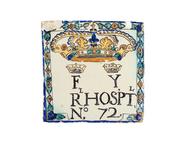





Tin-glazed earthenware syrup jar, polychrome decoration; labelled "OI LUBRUI" [Oil of earthworms], possibly from Castelli, 17th or 18th century
The inscription on the jar is in Latin and translates as “Oil of Earthworms”. The preparation for this treatment was as follows: take ½ lb (0.2 kg) of earth-worms, 2 lb (0.9 kg) of olive oil and 2 oz (57g) of wine and boil together until the wine has evaporated. Store for later use. Unfortunately, the recipe does not state if the worms were to be alive or dead.
According to the pharmacists of the day, oil of earthworm was a pain reliever, especially for aching joints, and was also recommended for arthritis, rickets and cramp. The oil was probably rubbed on to the skin. However, one writer gives a warning saying “But they who trust much to it…will be disappointed”.
The religious figure at the bottom is probably St Ignatius of Loyola (1491-1556), the founder of the Society of Jesus, whose members are known as Jesuits. The letters IHS are the first three letters from the Greek name for Jesus.
Details
- Category:
- Medical Ceramic-ware
- Collection:
- Sir Henry Wellcome's Museum Collection
- Object Number:
- A42615
- Materials:
- earthenware (tin-glazed)
- Measurements:
-
overall: 247 mm x 142 mm x 205 mm,
- type:
- syrup jar



